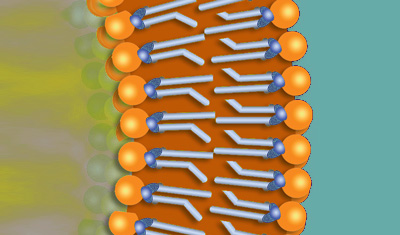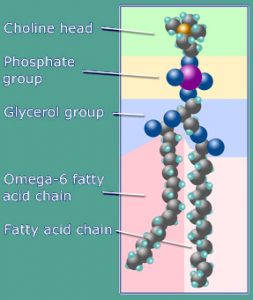Essential Phospholipids: Fundamental Facts
Essential Phospholipids: Basis
 Essential Phospholipids are the primary building blocks of cellular membranes. These membranes are the “containers” that hold the living matter within each cell. They also give definition, shape, and protection to many of the substructures (organelles within the cell like the nucleus and mitochondria) within our cells. Phospholipids align themselves in a tail-to-tail formation with their heads facing outward which creates a double layer membrane. This bilayer structure is used by cells throughout the body for outer membranes as well as for structures inside each cell.
Essential Phospholipids are the primary building blocks of cellular membranes. These membranes are the “containers” that hold the living matter within each cell. They also give definition, shape, and protection to many of the substructures (organelles within the cell like the nucleus and mitochondria) within our cells. Phospholipids align themselves in a tail-to-tail formation with their heads facing outward which creates a double layer membrane. This bilayer structure is used by cells throughout the body for outer membranes as well as for structures inside each cell.
In addition to functioning as a skin for each cell — keeping the insides in and the outsides out — phospholipid membranes provide protection from chemicals and pathogens that can derail and/or destroy the necessary life functions that take place within each cell. While performing this function, phospholipid membranes are subject to constant attack from free radicals (oxidants), pathogens, and toxins. In order to repair the structural damage caused by the continual barrage of toxic substances and pathogens, your body requires a constant supply of phospholipids. The body can synthesize some phospholipid compounds but others must be supplied by the diet. Phospholipids that can only be obtained through dietary intake are called “essential phospholipids.”
Anatomy of a phosphatidylcholine molecule.
 All phospholipids have a phosphate group and fatty acid chains connected by a glycerol group. Phosphatidylcholine, a class of essential phospholipids, has two distinguishing characteristics: 1) a choline head and 2) one of the fatty acid chains is an omega-6 fatty acid. (KEY — Gray: carbon atoms; Teal: hydrogen atoms; Blue: oxygen atoms; Violet: phosphorus atom; Gold: nitrogen atom.) Unlike phosphates, which are attracted to water (hydrophilic), fatty acids are repelled by water (hydrophobic). It is this very love/hate relationship with water that allows phospholipids to form cellular membranes — and liposomes as well. As phospholipids are exposed to water-based solutions, they automatically align themselves in a double-layer (bilayer) configuration – phosphates toward the water and fatty acids away from the water. One of the most important and prominent phospholipids in cell membranes is called phosphatidylcholine (PC) [pronounced FOSS-fah-tide-al-KOH-lean]. At birth up to 90% of cellular membranes are made up of PC. As humans age, the percentage of PC in their cellular membranes can decrease to about 10%. This fact leads many to recommend consistent supplementation with this essential phospholipid. Intact PC — as well as its essential fatty acid and choline components — is required for many vital functions in the cardiovascular, reproductive, immune, and nervous systems. PC and its components are needed for the synthesis of important messenger molecules called prostaglandins which, among other functions, regulate the contraction and relaxation of muscles. Choline is required for the synthesis of intracellular messenger molecules including the neurotransmitters that allow nerve cells to communicate with muscles and each other, and are essential for proper heart and brain function.
All phospholipids have a phosphate group and fatty acid chains connected by a glycerol group. Phosphatidylcholine, a class of essential phospholipids, has two distinguishing characteristics: 1) a choline head and 2) one of the fatty acid chains is an omega-6 fatty acid. (KEY — Gray: carbon atoms; Teal: hydrogen atoms; Blue: oxygen atoms; Violet: phosphorus atom; Gold: nitrogen atom.) Unlike phosphates, which are attracted to water (hydrophilic), fatty acids are repelled by water (hydrophobic). It is this very love/hate relationship with water that allows phospholipids to form cellular membranes — and liposomes as well. As phospholipids are exposed to water-based solutions, they automatically align themselves in a double-layer (bilayer) configuration – phosphates toward the water and fatty acids away from the water. One of the most important and prominent phospholipids in cell membranes is called phosphatidylcholine (PC) [pronounced FOSS-fah-tide-al-KOH-lean]. At birth up to 90% of cellular membranes are made up of PC. As humans age, the percentage of PC in their cellular membranes can decrease to about 10%. This fact leads many to recommend consistent supplementation with this essential phospholipid. Intact PC — as well as its essential fatty acid and choline components — is required for many vital functions in the cardiovascular, reproductive, immune, and nervous systems. PC and its components are needed for the synthesis of important messenger molecules called prostaglandins which, among other functions, regulate the contraction and relaxation of muscles. Choline is required for the synthesis of intracellular messenger molecules including the neurotransmitters that allow nerve cells to communicate with muscles and each other, and are essential for proper heart and brain function.